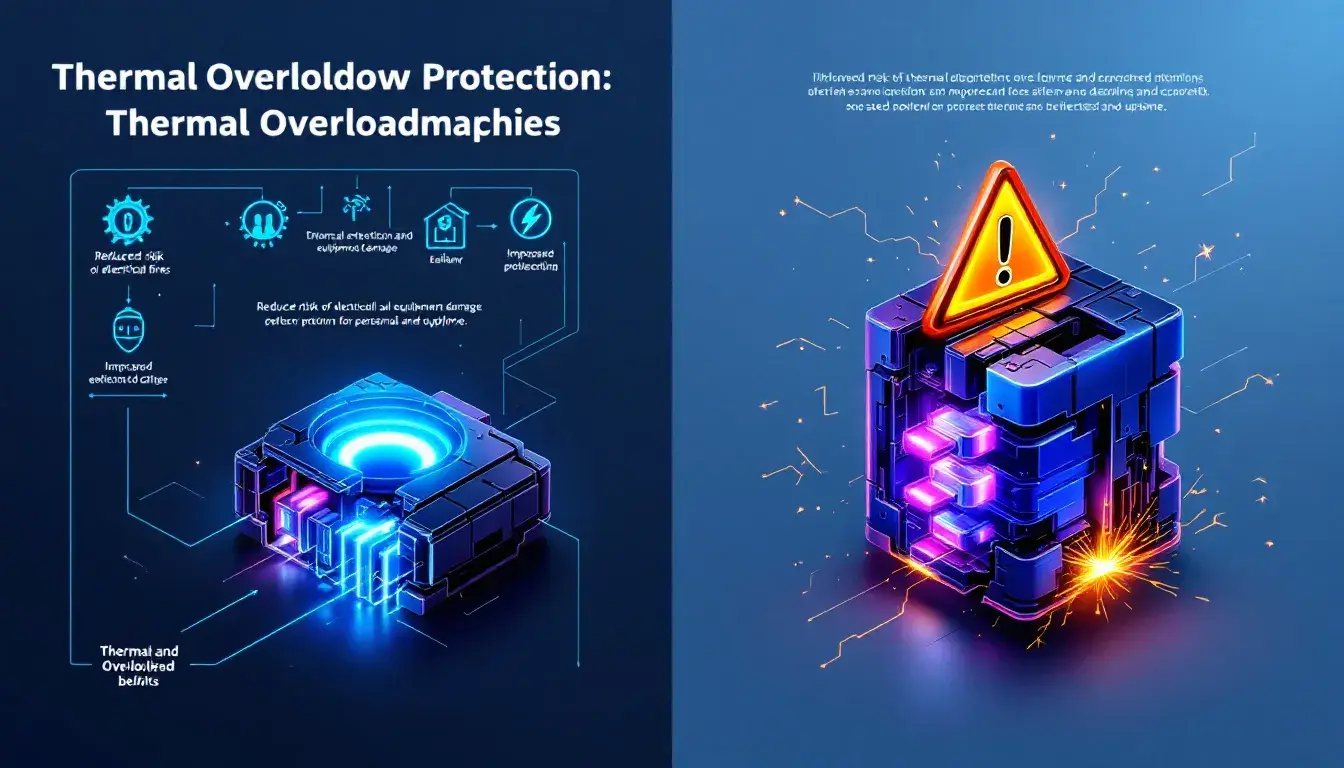What is the Symbol for Circuit Breakers?
Table of Contents
ToggleCircuit breaker symbols are essential tools for understanding electrical diagrams. They represent various types of circuit breakers and ensure safe, efficient system design.
Knowing these symbols helps professionals identify, install, and troubleshoot components with precision.
Read on to learn what these symbols are and how to identify them.
What is a Circuit Breaker Symbol?
Circuit breaker symbols are standardized graphical representations used in electrical schematics to denote circuit breakers.
These symbols provide a universal language for engineers, electricians, and technicians, allowing them to interpret diagrams accurately and work safely.
The symbols convey information about the type, size, and function of circuit breakers, ensuring compatibility and proper usage within the system.
They also play a vital role in maintaining compliance with safety standards like the International Electrotechnical Commission (IEC) and the American National Standards Institute (ANSI).
Understanding these symbols is critical for anyone working with electrical systems, as they help prevent errors, reduce downtime, and promote safety.
Key Types of Circuit Breaker Symbols
Credits to: ElectricalTechnology
a. MCB Circuit Breaker Symbol
Miniature Circuit Breakers (MCBs) are commonly used in residential and small commercial applications to protect against overcurrent and short circuits.
The symbol for an MCB typically consists of a rectangle with a break in the middle, indicating the breaker’s ability to interrupt the flow of electricity.
MCBs are widely appreciated for their compact size, ease of installation, and reliable protection. Understanding their symbol is essential for professionals working on smaller electrical systems.
b. MCCB Symbol
Molded Case Circuit Breakers (MCCBs) are designed for higher current ratings and are used in industrial and commercial environments.
Their symbol is often more detailed, featuring a rectangle with additional lines or annotations to indicate higher capacity and functionality.
MCCBs provide adjustable trip settings, making them versatile for various applications.
Their symbol represents their robust construction and ability to handle higher loads, a critical aspect of large-scale system designs.
c. Air Circuit Breaker Symbol
Air Circuit Breakers (ACBs) are used in high-voltage applications, such as power plants and large industrial facilities. Their symbol typically includes a rectangle with curved lines, representing the arc extinguishing process.
ACBs are crucial for protecting large-scale electrical systems from overcurrent and short circuits.
Recognizing their symbol ensures that professionals can identify and handle these breakers properly in complex environments.
Applications of Circuit Breaker Symbols
Circuit breaker symbols serve as a blueprint for planning and maintaining electrical systems.
They are widely used in:
- Residential Systems: Ensuring proper installation and protection for household circuits.
- Commercial Buildings: Managing electrical loads and preventing power disruptions.
- Industrial Settings: Safeguarding complex machinery and high-voltage systems.
These symbols help technicians quickly identify components, facilitating efficient troubleshooting and system upgrades.
How to Read and Interpret Circuit Breaker Symbols
Reading and interpreting circuit breaker symbols is a crucial skill for anyone working with electrical systems.
These symbols condense complex information into easily recognizable visual elements, making it easier to plan, troubleshoot, and maintain circuits.
Here’s a detailed guide to understanding these symbols:
Step 1: Identify the Breaker Type
The first step in interpreting a circuit breaker symbol is to determine the type of breaker it represents.
Look for distinguishing features such as unique shapes, additional lines, or annotations.
For instance, an MCB (Miniature Circuit Breaker) may have a simple rectangular symbol with a break in the middle, while an MCCB (Molded Case Circuit Breaker) could feature more complex details to indicate its higher current capacity and trip settings.
Familiarizing yourself with common symbols used for specific breaker types can significantly improve accuracy and efficiency.
Step 2: Check for Standards
Circuit breaker symbols often adhere to specific international or regional standards, such as IEC (International Electrotechnical Commission), ANSI (American National Standards Institute), or JIS (Japanese Industrial Standards).
Verify that the symbol matches the standard relevant to your project or region.
For instance, IEC symbols tend to be simpler and more universal, while ANSI symbols may include more detailed annotations to provide additional context.
Step 3: Cross-Reference with Manuals and Documentation
Equipment manuals and technical documentation often include detailed descriptions and illustrations of circuit breaker symbols.
When in doubt, consult these resources to confirm the meaning of a particular symbol.
Manufacturers may also provide custom symbols for proprietary equipment, making it essential to reference their specific guides.
Step 4: Understand the Context in the Diagram
Symbols often gain meaning from their placement within an electrical schematic.
Look at the surrounding components and connections to determine the circuit breaker’s role in the system.
For example, a circuit breaker symbol next to a transformer may indicate it protects the transformer from overcurrent.
Step 5: Practice with Real-World Examples
Experience is key to mastering the interpretation of circuit breaker symbols.
Practice by reviewing different electrical schematics and identifying the symbols.
Online resources, simulation tools, and hands-on training can also help reinforce your understanding.
Symbol Variations Across Standards
Circuit breaker symbols may vary depending on regional or international standards. For instance:
- IEC Standards: Focus on simple, universally recognized symbols.
- ANSI Standards: Include more detailed annotations for clarity.
- JIS Standards: Common in Japan, with unique design elements.
Understanding these variations is crucial for professionals working on international projects or systems with mixed components.
Circuit Breaker Symbol FAQs
What is the standard symbol for a circuit breaker?
The standard symbol for a circuit breaker varies depending on the type and the standards followed, such as IEC or ANSI.
Generally, it is represented by a rectangle with a line or break indicating the interrupting mechanism.
For example, a single-pole circuit breaker symbol may appear as a simple rectangle with a line through it.
How do you identify different circuit breaker symbols in a schematic?
Identifying circuit breaker symbols involves recognizing the specific shapes and annotations that correspond to different breaker types.
For instance, an MCB (Miniature Circuit Breaker) symbol might be a simple rectangle with a break, while an MCCB (Molded Case Circuit Breaker) symbol could include additional lines or details indicating higher capacity.
Familiarity with standard symbols and consulting reference materials can aid in accurate identification.
Are circuit breaker symbols standardized internationally?
Yes, circuit breaker symbols are standardized to ensure consistency across different regions and industries.
Organizations like the International Electrotechnical Commission (IEC) and the American National Standards Institute (ANSI) have established standard symbols.
However, there may be slight variations between these standards, so it’s essential to be aware of the specific standards applicable in your region.
Why is it important to understand circuit breaker symbols?
Understanding circuit breaker symbols is crucial for designing, interpreting, and troubleshooting electrical systems.
These symbols provide essential information about the type and function of circuit breakers within a circuit, facilitating proper installation and maintenance, and ensuring safety and compliance with relevant standards.
Circuit Breaker Symbols: Conclusion
Circuit breaker symbols are indispensable for designing, maintaining, and troubleshooting electrical systems.
By mastering these symbols, professionals can ensure safety, efficiency, and compliance with standards, making their work more effective and reliable.
Tel: +86-577-88671000
E-mail: ceo@tosun.com
Skype: tosunelectric
Wechat: +86-139 6881 9286
WhatsApp: +86-139 0587 7291
Address: Room No.1001 Wenzhou Fortune Center,Station Road, Wenzhou, China
REQUEST A QUOTE
WhatsApp us
 : +86-139 0587 7291
: +86-139 0587 7291 English
English Español
Español Русский
Русский Français
Français العربية
العربية Português do Brasil
Português do Brasil Українська
Українська Türkçe
Türkçe Polski
Polski Nederlands
Nederlands Italiano
Italiano Bahasa Indonesia
Bahasa Indonesia हिन्दी
हिन्दी اردو
اردو አማርኛ
አማርኛ Հայերեն
Հայերեն ไทย
ไทย Монгол
Монгол فارسی
فارسی Shqip
Shqip Ελληνικά
Ελληνικά


